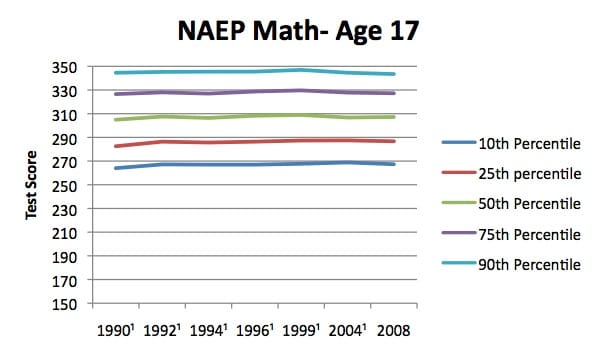One of the great mysteries of modern-day school reform is why we’re seeing such strong progress (in math at least, especially among our lowest-performing students) at the elementary and middle school levels, but not in high school.
Consider: Nine-year-olds at the 10th percentile posted 12 points of progress between 1990 and 2008 on the long-term National Assessment of Educational Progress—10 of those points between 1999 and 2004 alone. (That’s about a grade level’s worth of gains.) Thirteen-year-olds at the 10th percentile posted 7 points of progress from 1990 and 2008. But seventeen-year-olds at the 10th percentile only gained 3 points. (The story is much the same for the 25th percentile.) The story for reading is more sobering, with big gains at the nine-year-old level, a flattening out in middle school, and actually declines in high school.
 |
The question is how to interpret these trends. One hypothesis is about fade-out: The improvements at the elementary level are ephemeral, perhaps because the way math or reading is taught doesn’t set students up for future success. In reading, for example, it’s quite likely that a heavy focus on phonics is helping students to decode better—and post better scores as nine-year-olds—but isn’t giving them the vocabulary or content knowledge to keep making progress in middle school. Another hypothesis is that our high schools aren’t as strong as our elementary schools, perhaps because they haven’t been the focus of as much reform and attention.
Let me float a third theory: Could it be that increased graduation rates are driving down twelfth-grade performance? Recent studies have indicated that graduation rates are up significantly over the past decade; that means that we have twelfth-graders in school today who previously would have dropped out. And those students are likely to be very low-achieving. Could they be pulling down the mean? Just like we see with the SAT as more students—and more lower-income students—take the exam?
I’m not a statistician but it seems plausible to me. Number-crunchers out there: What say ye?
